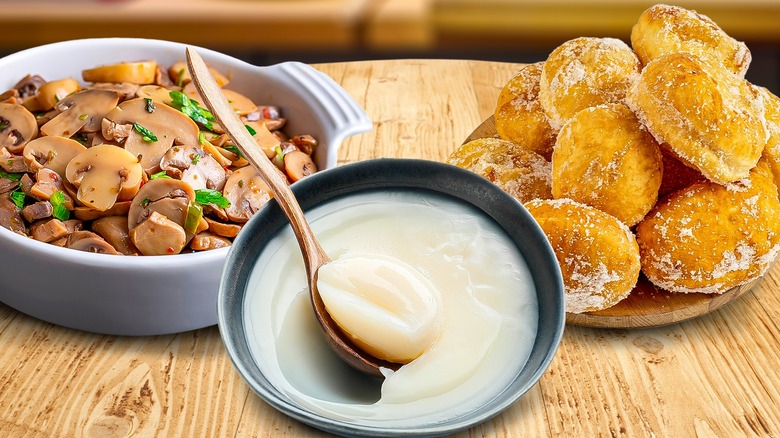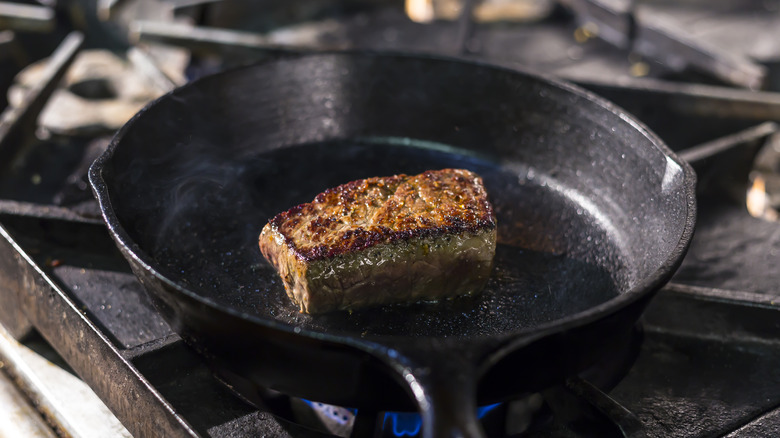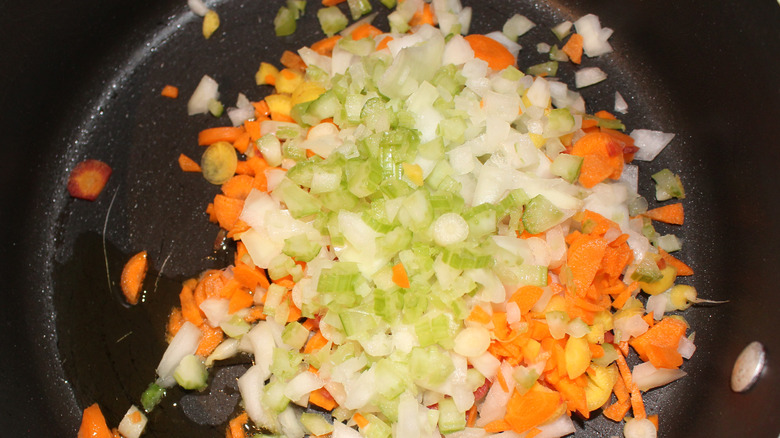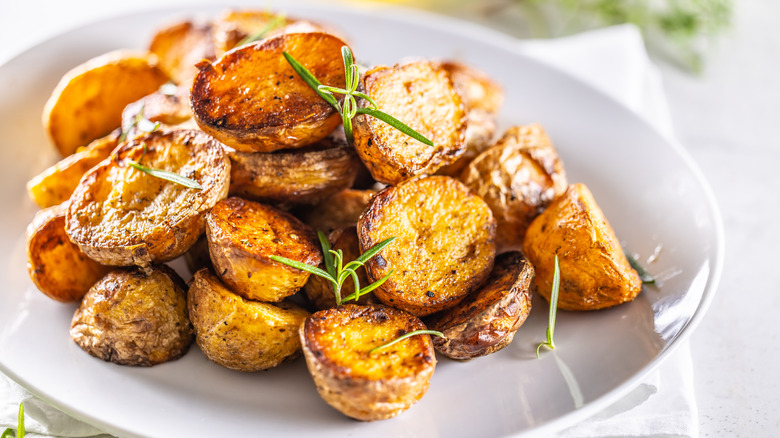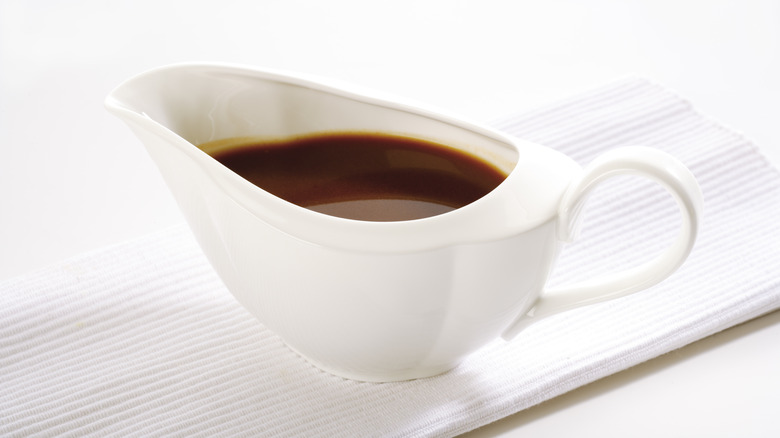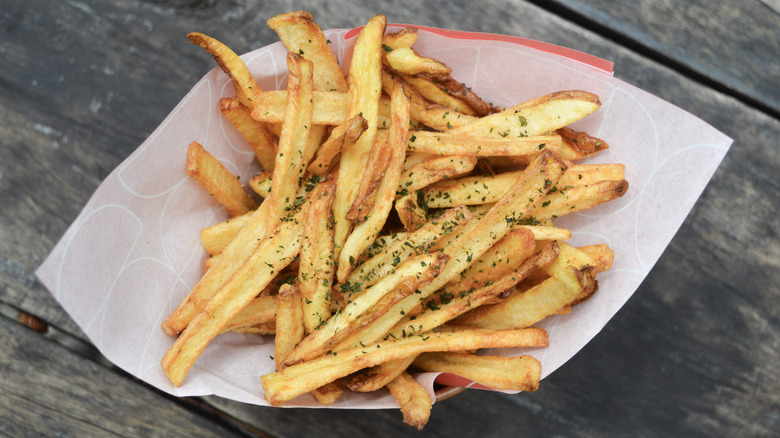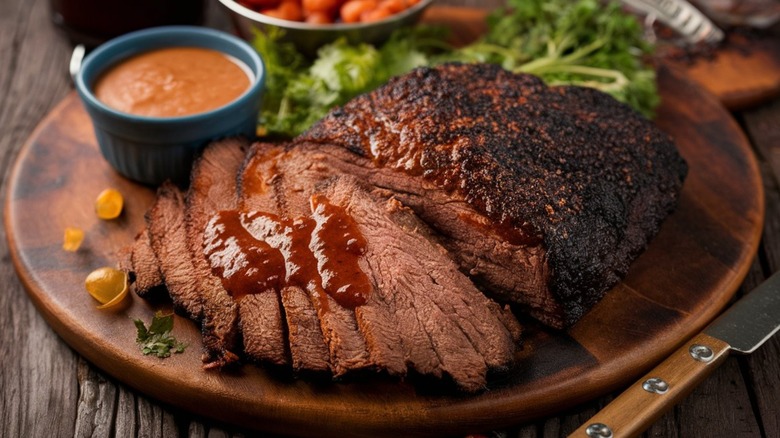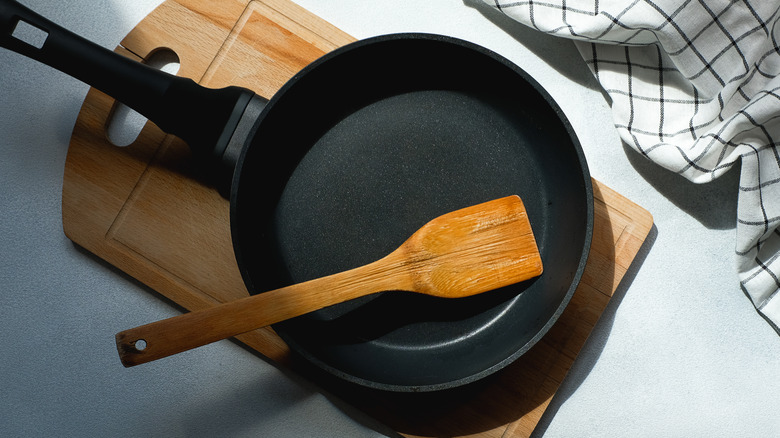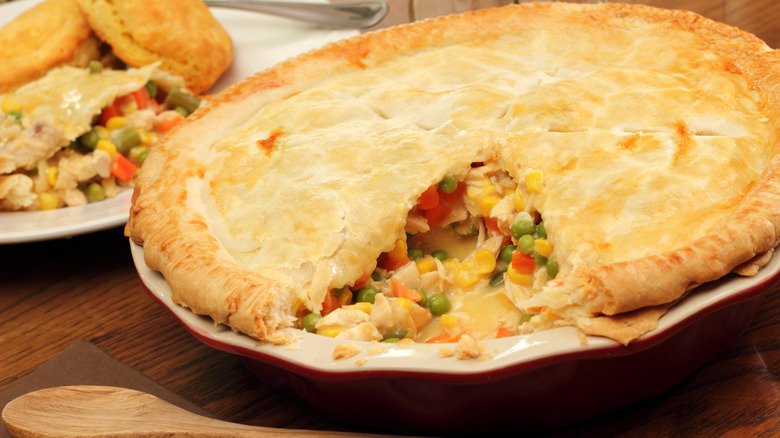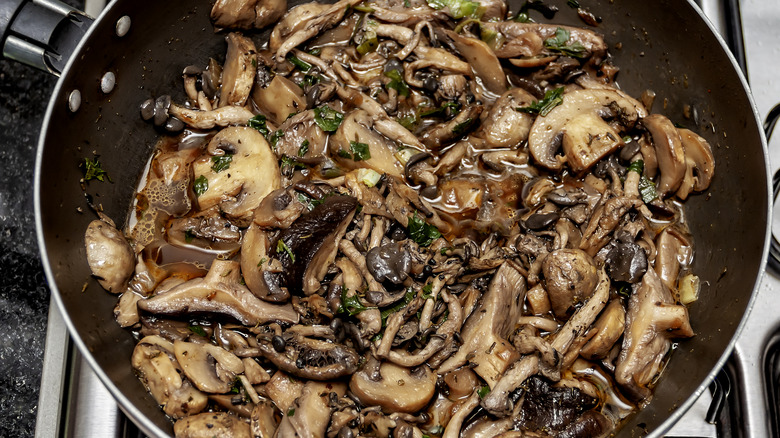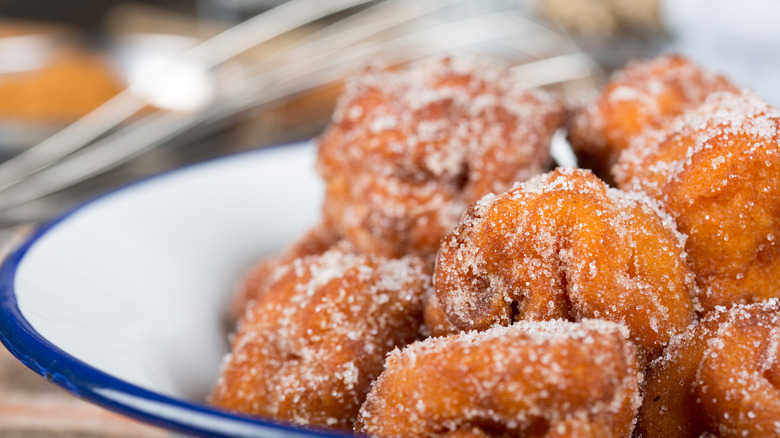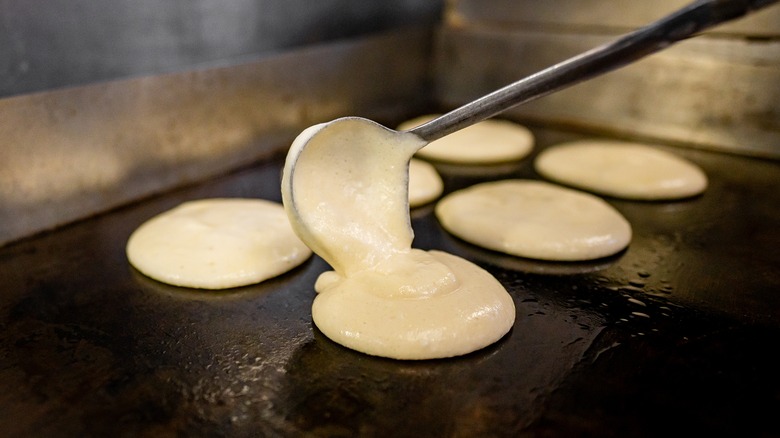11 Simple Ways To Cook With Beef Tallow
Move over canola oil, sesame oil, and the ever-popular EVOO — there's a new cooking fat in town. Beef tallow, which is made by rendering and straining beef fat (or by picking it up at the butcher or grocery store), is a great alternative to use when frying, sautéing, roasting, and even grilling. Cooking with this shelf-stable fat is a simple and delicious way to add unique flavor to your food, as it retains much of the savoriness and umami of its original form. It is great for high heat cooking in everything from baked goods to seasoning cast iron pans.
Beef tallow is also high in numerous vitamins, as well as unsaturated healthy fat. Compared to other cooking fats and oils, tallow has more nutritional benefits which has made it popular with those looking to optimize their diet for the maximum benefit. It certainly doesn't hurt that cooking with beef tallow adds a deliciously complex and rich savory taste to your food as well.
While the process of making your own beef tallow might be more work than you want to put in, there are plenty of cooking methods that are simple. Beef tallow can often be used interchangeably with other cooking oils, getting better results and tastier food without requiring specialized knowledge or skill. Get ready to keep things simple and amazingly delicious with these beef tallow tips and tricks.
Searing
Searing requires super high heat to create the perfect crust full of flavor and the right kind of texture. However, finding the best cooking oil to sear steak can be difficult when you consider that many start to smoke and burn before the pan is hot enough to get a good sear.
Making sure that the pan is sizzling before you put your food in is key to getting the right texture on the outside without overcooking the inside. If you use an oil or fat with a low smoke point, though, it's likely to burn before that point. Beef tallow has a smoke point of around 400 F,so you can get the pan very hot before putting meat or fish on it. "Tallow has a high smoke point and offers rich flavor compared to any cooking oil," says Brian Smith, co-owner of The Butchery, an Orange County-based butcher shop. "Melt the tallow in a hot skillet before adding your protein."
You can sear any type of meat in beef tallow, but it's not surprising that beef pairs particularly well with the flavor. Other meats that need a crispy exterior are also perfect candidates to sear with tallow. "Beef tallow is perfect for searing any protein," says Smith. "It's my go-to for a perfect crust. Use it for steaks, roasts, poultry, pork and even fish."
Sautéing vegetables
Beef tallow isn't just for meat and protein. Using it as a cooking fat in your dish adds extra depth of flavor to vegetables when you sauté. At room temperature, beef tallow is solid, which makes it easy to store. Once you heat it, though, the tallow melts and creates the perfect base to add vegetables like peppers, mushrooms, squash, and others. If you want to boost the flavor, start with mirepoix, or a mixture of chopped onions, carrots, and celery that is used in many savory recipes. Along with sofrito, which is a similar blend of aromatics with added spices, mirepoix is used to add flavor to beef dishes. It makes sense that this miracle combination is made even better by the addition of umami-rich beef tallow flavor from the beginning.
It works to stir fry a variety of veggies and proteins together as well, since it complements both flavors. "It adds a savory depth to onions, bell peppers, and greens, enhancing their natural sweetness," says Brian Smith. "It's a great choice for stir-fry or side dishes." Unlike some oils that have a neutral taste, tallow is rich and adds extra body to your dish.
Roasting potatoes
Using beef tallow when roasting potatoes creates a deliciously savory side dish with very little effort. It also works well because the fat helps the outside of the potatoes becomec crunchy and flavorful. "Tossing potatoes in melted beef tallow before roasting creates crispy, golden exteriors," says Brian Smith. "The tallow not only adds flavor but also helps achieve that perfect crunch."
While it doesn't take much while roasting the potatoes, you do need to melt the tallow ahead of time to make sure it coats the potatoes evenly. "Simply coat diced potatoes with tallow, season, and roast until tender," says Smith. You can cut the potatoes into pieces or wedges for faster cooking, not to mention more surface to get crisped. If you want larger pieces of potato, you can halve your spuds. Just be ready to adjust the roasting time to get the inside tender and hot. Fortunately, beef tallow can be in the oven for a long time without smoking or burning.
Ashley Lonsdale, chef-in-residence at ButcherBox, loves the potato and beef tallow combination, relying on it when using a few different methods. "Use it for searing off squares of potato pavé," she recommends. "For a less time-intensive side dish, beef tallow is great for frying simply diced potatoes. Diner hashbrowns with onions, peppers, and loads of black pepper are also a great choice."
Making a roux
Beef tallow adds a deep, savory flavor to dishes, making it a perfect start for sauces and gravy. If you're planning to pair your gravy with roast beef, it complements the taste of the meat, but it also works with other proteins. Don't be afraid to venture out with new flavor combinations, relying on the tallow to bring in the savory element. "You can build on this flavorful foundation with stock and seasonings, making for a rich sauce that pairs well with meats and vegetables," says Brian Smith.
One of the easiest ways to incorporate beef tallow is to use it at the beginning of your gravy-making. "Start your gravies and sauces with beef tallow as a base," says Smith. "Melt it in a pan and whisk in flour to create a roux." From there, you can mix in spices and seasonings, as well as other ingredients like butter or wine to make the flavor even more complex. If you pour tallow-based gravy over tallow-roasted potatoes, get ready for the enthusiastic dance your taste buds are about to do.
You can also use beef tallow to boost your pan sauce when searing steaks. When you cook steak in a pan, the fat that is left behind is similar to beef tallow. Adding a little bit of extra fat, along with beef or chicken stock, helps release the burnt-on bits at the bottom of the pan to add even more flavor to your sauce.
Frying foods
Want the perfect french fry? Beef tallow might just be the answer that you're looking for to get your fries extra crispy and to add a rich flavor. This potato-tallow combination is so great that it deserves its own callout for creating some of the best fries on the planet. "The tallow provides a unique taste and helps achieve a crispy texture, elevating your fried dishes," says Brian Smith, who uses beef tallow at The Butchery's restaurant to make french fries.
The starchiness in potatoes makes an especially good pairing with savory beef tallow, but you can rely on this fat when frying other foods as well. "Use beef tallow for frying, whether shallow or deep, to achieve crispier and less greasy results," says Greg Hozinsky, chef at Coast Packing Company in Vernon, California. "Beef tallow maximizes flavor, stability, and durability while being minimally processed, bringing vintage goodness without artificial trans fats or hydrogenated oils."
McDonald's famously crispy and flavorful french fries were originally cooked in beef tallow, giving them their famous golden color and perfect texture. While the fry oil has changed over the years, it still incorporates beef flavoring. If you want to replicate the Golden Arches' iconic fry taste in your own preparation, give beef tallow a shot.
Barbecue meats
Beef tallow doesn't have to be limited to the kitchen. You can take this versatile cooking fat outside to enhance the food at your next backyard barbecue or when smoking meats. "Wrap barbecue briskets in butcher paper or foil with beef tallow for extra richness," suggested Greg Hozinsky. Adding beef tallow to brisket or other roasted meats before wrapping in foil is also easy, since the tallow can be at room temperature when you place it in the foil packet. It adds a lot of flavor and keeps the meat moist, melting as the meat cooks on the grill. Rubbing the exterior of your steak with melted beef tallow also helps create the perfect crust as it grills over high heat, whether on a griddle or open flame.
Ashley Lonsdale also breaks out the beef tallow to make homemade barbecue sauce. She uses it when caramelizing onions, then simmers the base with molasses, brown sugar, Dijon mustard, and tomato paste. The result is a sweet sauce that is perfect for grilled meats. The rich flavor of the tallow adds extra depth to the sauce, which has sweetness from the aromatics, molasses, and sugar. A bit of zing from mustard and acidity from tomato paste round out the flavors.
Maintain cooking equipment
Beef tallow has applications for chefs beyond cooking or serving food. As a rich shelf-stable fat, it makes the perfect seasoning for kitchen utensils, pans, and other key tools of the trade. "Use beef tallow to condition cooking tools, such as seasoning wood cutting boards or a cast-iron skillet," says Greg Hozinsky. Cast iron in particular needs oil to maintain its surface, which is ideal for preparing everything from a perfectly seared steak to sweet cornbread. Beef tallow is the perfect fat to use since it is easily applied and adds a boost of subtle, rich flavor.
A little bit of beef tallow also goes a long way when it comes to this type of application. It does not require any special preparation and solid when stored in the pantry or fridge, so getting a small amount is easy and convenient. Simply scoop out a little bit of tallow and rub it on the cooking or prep portion of your item. Wipe away any excess, taking care to give the entire cast iron or wooden surface a thorough once-over. If you leave extra tallow on the pan or utensils, it will have a stronger impact on your cooking the next time you pull that item out. It can also get scratched or transfer the oil or fat to other pots and pans, so be careful when storing seasoned cookware.
Make savory pie crust
Sometimes, it's easier to pick up a store-bought pie crust, but whipping up your own may be simpler than you thought. When you add beef tallow to the mix, it can take on a much richer flavor as well. "Beef tallow is an excellent option for making a savory pie crust," says Ashley Lonsdale, chef-in-residence at ButcherBox. She notes that the chemical composition of beef tallow is similar to butter, so you can use it to replace the dairy-based fast in many applications, including baking. "It replaces shortening or butter seamlessly." You can use tallow as a one-to-one substitute without any alteration to the recipe. Like butter, it is solid but begins to soften as it warms. Depending on your recipe and application, you may be able to incorporate it cold or need to melt it before mixing it into batter.
Beef tallow adds a unique flavor and keeps the crust flaky, both aspects that are great for pie. The flavor works best with savory recipes, including pot pie or handheld pies, but it can taste delicious with fruit and desserts as well. If you want or need to avoid dairy, tallow is a fantastic alternative to butter.
Pair with mushrooms
It's hard to overstate how great beef tallow is for frying and roasting, but it also works beautifully when you want to sauté. Because of its umami-rich flavor, it pairs well with other earthy ingredients. Ashley Lonsdale loves the combination of beef tallow and mushrooms, which she cooks in a sauté pan. "If I have rendered beef tallow, one of my favorite ways to use it is to sauté or roast mushrooms," she says. "It emphasizes the savory notes in mushrooms, especially wild varieties." Most supermarkets carry standard kinds of mushroom, such as white button mushrooms or portobellos. However, don't be afraid to venture out and try something new, such as hen-of-the-woods or oyster mushrooms, which have different flavor profiles and textures. Because they are made of tiny fibers and take on the tastes of other ingredients, mushrooms are a perfect substitute for meat. You can stick with the grocery store or visit your local farmer's market to search out more unique edible fungi.
You can also fry mushrooms in melted beef tallow as well, adding a crispy texture to the outside of the tender, savory vegetable. Play with different coatings and seasonings to change up the flavor. You can replace olive oil with tallow, taking advantage of its high smoke point and rich flavor to fry up just about any variety of mushroom.
Fried pastries
Even though it's rendered from meat, beef tallow doesn't need to strictly stay with savory dishes. If you can fry it, it can be done in beef tallow for and extra rich and delicious taste. Sweet treats can get an unexpected flavor boost when fried in tallow, which works so well because it is solid rather than liquid when stored. Liquid oils tend to give fried pastries a soggier texture overall. Because it has a high smoke point, tallow is also less likely to burn and negatively impact the taste of your goodies.
"Fry pastries like donuts, funnel cakes, or malasadas with beef tallow for a delicious treat," says Greg Hozinsky. "Enhance bakery items with a savory component, like beef fat, for incredibly savory pastries." While the exact origin of fried dough dishes dates back hundreds of years, tallow and other animal fats were actually the original frying oils used to create donuts as they first gained popularity in their current form. Using tallow or other animal fats creates a firmer donut with a crispy exterior. This is perfect to support glaze or a powdered sugar coating, since the donut is sturdy enough to keep its shape with toppings. Tallow also works for savory pastries, including samosas and hushpuppies.
Use with a griddle or blackstone
Breakfast gets a savory kick when you fry it up on a piping hot surface with beef tallow. You can use it for everything from hash browns to fried eggs on the griddle. It adds flavor and has a high smoke point, which works for these dishes. Simply put a small amount of tallow on the griddle and let it melt as the surface heats. You don't need a lot of tallow to get the taste and texture that you want.
"Enhance the flavors of your breakfast foods with beef tallow on a griddle or a Blackstone," says Greg Hozinsky. Tallow has a distinct meaty flavor, which works well with eggs, bacon, potatoes, and even sweet items like pancakes. If you want to take things to the next level with fried eggs, baste them in the tallow as they cook. You'll be rewarded with extra crispy edges while still maintaining the perfect center yolk.
